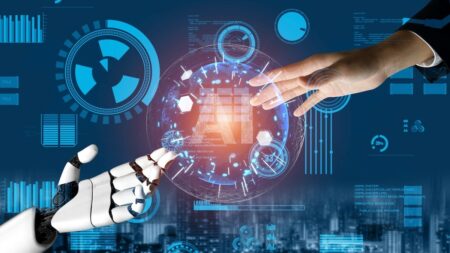AI transforming the world is the next stage of digital transformation. To keep ahead of the competition, businesses are eager to invest in AI technology. According to Andrew Ng, AI Transformation is a process that might take two to three years, but businesses can begin to benefit from it in as little as six to twelve months.
Because digital data is required for AI training and, in most cases, digital procedures are required to roll out AI solutions, firms must first undergo a digital transformation before they can begin their AI transformation. If you think that your business has not yet made progress on its digital transformation path, feel free to read about what digital transformation is and our in-depth digital transformation guide.
visit the previous article: https://www.techcreative.me/10-top-procureme…software-in-2022/
AI definition
It’s crucial to characterize AI technologies before studying how they are affecting business. “Artificial intelligence” is a broad term used to describe any kind of computer software that performs human-like tasks like planning, problem-solving, and learning. It’s theoretically valid to refer to certain applications as “artificial intelligence,” but that doesn’t include any of the intricacies. We need to go further to determine the sort of AI that businesses are using most frequently.
computer learning
One of the most prevalent categories of AI currently being developed for commercial use is machine learning. The main purpose of machine learning is to swiftly process enormous volumes of data. This artificial intelligence (AIs) uses algorithms that seem to “learn” over time.
A machine-learning algorithm’s modelling should get better as more data is fed into it. With the help of machine learning, large data sets that are increasingly being collected by linked devices and the Internet of Things may be translated into a human-digestible context with the help of machine learning.
For instance, if you are in charge of a manufacturing facility, the network is probably connected to your equipment. A central site receives a steady stream of data from connected devices concerning the functioning, production, and other topics. A person would never be able to go through all of the data, and even if they did, they would probably miss most of the patterns.
What does AI entail for employees
The terrifying question of whether robots would drive people out of employment is brought on by all these new AI applications. AI transforming the world is the next stage of digital transformation. The verdict is still out on whether or not AI will automate so many occupations that millions of people will become unemployed. Some experts adamantly refute this, while others believe it to be a serious issue.
According to Rahnama, “the employment structure is changing, but I don’t think artificial intelligence is fundamentally displacing jobs.” It enables us to develop a knowledge-based economy and use it to improve automation and lead better lives. It may sound a little bit speculative, but if you have to be concerned about robots and artificial intelligence taking human jobs, I believe algorithms will likely replace white-collar positions like business analysts, hedge fund managers, and attorneys.
There is a lot of disagreement about how artificial intelligence will change the workforce, but experts think we can expect a few things.
Can AI lead to job growth
Some analysts think that as AI becomes more prevalent in the workforce, it will increase employment, at least in the near future.
According to Wilson, the move to AI-based systems will probably result in the economy adding occupations that help with the change.
In this article, we learn about AI transforming. According to him, artificial intelligence will generate more income than it consumes, but it won’t be distributed fairly at first. Changes won’t be overt; they’ll only be sensed subliminally. A tax accountant won’t get laid off one day and meet the robot who will take her place at the desk. Instead, when the tax accountant tries to get a job again, it will be a little harder for her to get hired.
Wilson says that he thinks the use of AI in the workplace would break up established workflows and require the creation of many new jobs for people to put back together.
What happens following the changeover
First and foremost, this is a change that will affect several workforce sectors and take years, if not decades, to implement. AI transforming the world is the next stage of digital transformation. This makes it harder to make these predictions, but Husain and some other experts worry that as AI becomes more common, these extra jobs (and the ones that were there before) may start to go away.
Husain claimed that, as a result, he is uncertain of the long-term whereabouts of those employees. “There were possibilities to go from farming to industry to services in the past. That is not the situation right now. Why? Since the whole industrial sector has been automated, we can see that this is the better economic choice.
Husain used self-driving cars and AI concierges like Siri and Cortana as examples to say that if these technologies improve and become more widely used, up to 8 million jobs in the United States alone could be lost.
“We must question ourselves, ‘What does it take to make us productive?’ when all these jobs start disappearing.” “What is productivity? “he continued. “At this point, we are questioning the core presumptions of society and facing a changing reality.” We must really consider this and decide what motivates us to be productive as well as what defines a person’s worth in society.
What actions should be taken to change AI
The top 6 phases for Fortune 500 companies are shown below. Smaller businesses could forego building internal teams in favour of less risky and expensive strategies like hiring consultants for certain tasks.
#1. Describe your organization’s AI approach
Initiatives that will be discovered as a consequence of these exercises should be included in an AI strategy:
- Find the most useful, unique data sources for your business.
- Determine the critical processes that might benefit from automation.
- Determine the internal resources needed to advance the AI transition.
- Set challenging, time-bound corporate goals.
#2. Carry out test projects to generate momentum
The first few initiatives must be doable and produce quantifiable company value. In this article, we learn about AI transforming. This is crucial for the transition because it builds confidence among employees inside the company with regard to initiatives that have been completed, and it generates momentum that will make AI projects more successful.
These initiatives can make use of AI/ML-powered technologies available in the market, or for more specialized solutions, your business can hold a data science competition and draw on the experience of many data scientists. These contests make use of encrypted data and offer a cheap method of discovering effective data science solutions.
Process mining implementation is one of those doable and worthwhile initiatives. Your company may find current inefficiencies using a process mining tool and automate or enhance those operations to produce savings or improve customer experience. As a result, certain process mining technologies create a digital twin of an organization (DTO), which gives simulation capabilities to compare real-world and fictitious scenarios and provides an end-to-end picture of the processes in the firm.
Sponsored
Businesses may use IBM Process Mining to automatically monitor their processes, evaluate their performance, identify opportunities for automation and improvement, and compare them to rules and reference models. Start your 30-day free trial today to examine IBM Process Mining features like the organization’s digital twin (DTO).
Automating document-based procedures is another effective and simple project. A current AI/digital transformation project would eliminate manual labour and automate data extraction and processing of document data, whereas digital transformation initiatives in the 2000s were only concerned with getting rid of paper from operations.
#3. Establish a team for internal AI AI transforming
The AI transforming process can be started more easily by outsourcing the AI work, but setting up an internal AI transformation team may be more advantageous in the long term. If required, external partners can assist with employee training for prospective projects.
#4. Offer extensive AI training
Organizations shouldn’t count on their workforce to be sufficiently knowledgeable about AI technology. In this article, we learn about AI transforming. Training each person in line with their function can help to reach goals in order to have a successful AI transition.
Senior executives and managers need to understand how to create an AI strategy, how AI may benefit the business, and how to allocate resources effectively.
Allocate resources, monitor and measure progress, and determine the direction for AI projects. These are skills that team leaders in AI projects should master.
AI engineers should become proficient in data collection, model training, and project delivery.
#5. Establish internal and external communication channels
The firm has to improve internal and external communication to establish alignment throughout the business in order for the AI transition to be successful.
#6. Revisit the business’ AI strategy and carry out the AI AI transforming
The company will have a better knowledge of the areas where AI can produce the most value if the team gets momentum from the early AI initiatives and develops a deeper understanding of AI. AI transforming the world is the next stage of digital transformation. A revised plan that considers the company’s past performance can better define the company’s path.
It is really appreciated that Andrew Ng outlined the AI transformation phases in his AI Transformation Playbook. After establishing some early goals, we added more items to his list.
Future of work
#1. Facial identification
AI transforming use has steadily increased to permeate daily life. Face recognition software takes advantage of it every day. In this article, we learn about AI transforming. For many businesses, biometric authentication serves as the initial line of protection. With the use of a database created using machine learning, this method of authentication enables even the most formal institutions, like the US Internal Revenue Service, to confirm a person’s identification. The United States IRS will start requiring those who don’t have a live interview with an agent to perform a biometric identification verification using ID.me’s face recognition technology in 2022.
#2. Education and AI
Through the business Riiid, artificial intelligence software is employed in Japan and South Korea to teach English.
A live chat using artificial intelligence is one way that students at Riid, a Korean education firm collaborating with Japan, may practice and improve their English communication abilities.
It’s not only Riid that does this. A well-known American firm is Duolingo, which offers automatic language instruction in 41 different languages. Babbel, a German language learning tool, also makes use of artificial intelligence in its automation of the teaching process. As a result, European students are able to acquire the critical communication skills required in social, economic, and diplomatic contexts. The regular duties that instructors must perform, including grading, taking attendance, and responding to common student queries, will also be automated by artificial intelligence. As a result, the instructor may continue with the more sophisticated aspects of education that a machine cannot manage. These include creating tests, breaking down difficult subjects so that each student can understand them on their own, and responding to specific student inquiries.
#3. AI and healthcare
Contrary to the human brain, which possesses generalist intelligence, artificial intelligence (AI) has specialized intelligence that can help doctors throughout the world. The medical industry contains a vast and varied quantity of data that AI can use to produce a prognostic prognosis. Artificial intelligence has been created by researchers at a hospital in Oxford that can identify cancer and heart problems from cardiac scans. This artificial intelligence is capable of detecting minute characteristics in scans that doctors could overlook. Utilizing artificial intelligence in medicine will thereby advance the field by enabling clinicians to precisely diagnose their patients utilizing the available resources. Through a machine learning application known as precision medicine, artificial intelligence algorithms will also be employed to gradually enhance diagnostics. Additionally, “deep learning” may be used in the specific use of artificial intelligence to enhance medical image processing. Deep learning algorithms are used in medical imaging by AI to recognize possibly malignant tumours, a critical step that aids in early identification.
#4. AI in business for business
Artificial intelligence’s core ability to analyze data makes it applicable to every aspect of life, from search results to how people make purchases. According to NewVantage Partners, over 90% of leading companies have continuing investments in artificial intelligence. One of the top technology corporations in the world, IBM, reports that 45 percent of respondents from businesses with more than 1,000 workers have used AI. According to recent estimates, the corporate market for artificial intelligence in 2020 was estimated to be worth $51.08 billion. By 2028, it is expected that the corporate market for artificial intelligence will be worth more than $640 billion. To prevent damage, AI-deploying enterprises must accept responsibility for mitigating risks and play a significant role in developing and deploying trustworthy AI, according to the principles of trustworthy AI.
Which sectors are the most open to AI transformation
Markets are already beginning to be significantly impacted by artificial intelligence. In terms of adopting AI, sectors including the automotive, high-tech, communication, energy, and financial services have already made significant progress. AI transforming the world is the next stage of digital transformation. As increasingly digitized industries are anticipated to benefit more from AI technology, such inequalities are likely to endure.
What challenges face the transition of AI
The top challenges to AI transformation, per the same O’Reilly poll, are:
- Organizational AI talent and experience are insufficient.
- Issues with data quality and insufficient data
- discovering relevant business use cases might be difficult.
- The benefit of AI is not recognized in corporate culture
What are the ideal techniques
According to our analysis of the available research and interviews:
- Investments in technology alone should not be the only focus of AI projects. It’s important to not undervalue the role that process and people play in change.
- The adoption of AI cannot come at the expense of strategy. To have a positive influence on the company’s bottom line, AI investments should be in line with those aims.
- The organization’s whole technological strategy and infrastructure must be restructured in order to implement artificial intelligence throughout business processes.
- Leading the AI functions should be accomplished by experts in machine learning and artificial intelligence deployments.
FAQ
Four stages to successful AI and machine learning?
First, lay the foundation.
- step 1: is to be ready to transfer your data and apps to the appropriate multicloud and data architecture environments.
- step 2: Modernize the data architecture.
- step 3: Prepare the ground for more innovation.
- step 4: Create clever apps.
What does AI transform mean?
AI transformation is the process of using artificial intelligence to drive digital transformation, integrate AI into every aspect of a business, and alter how value is provided to consumers.









